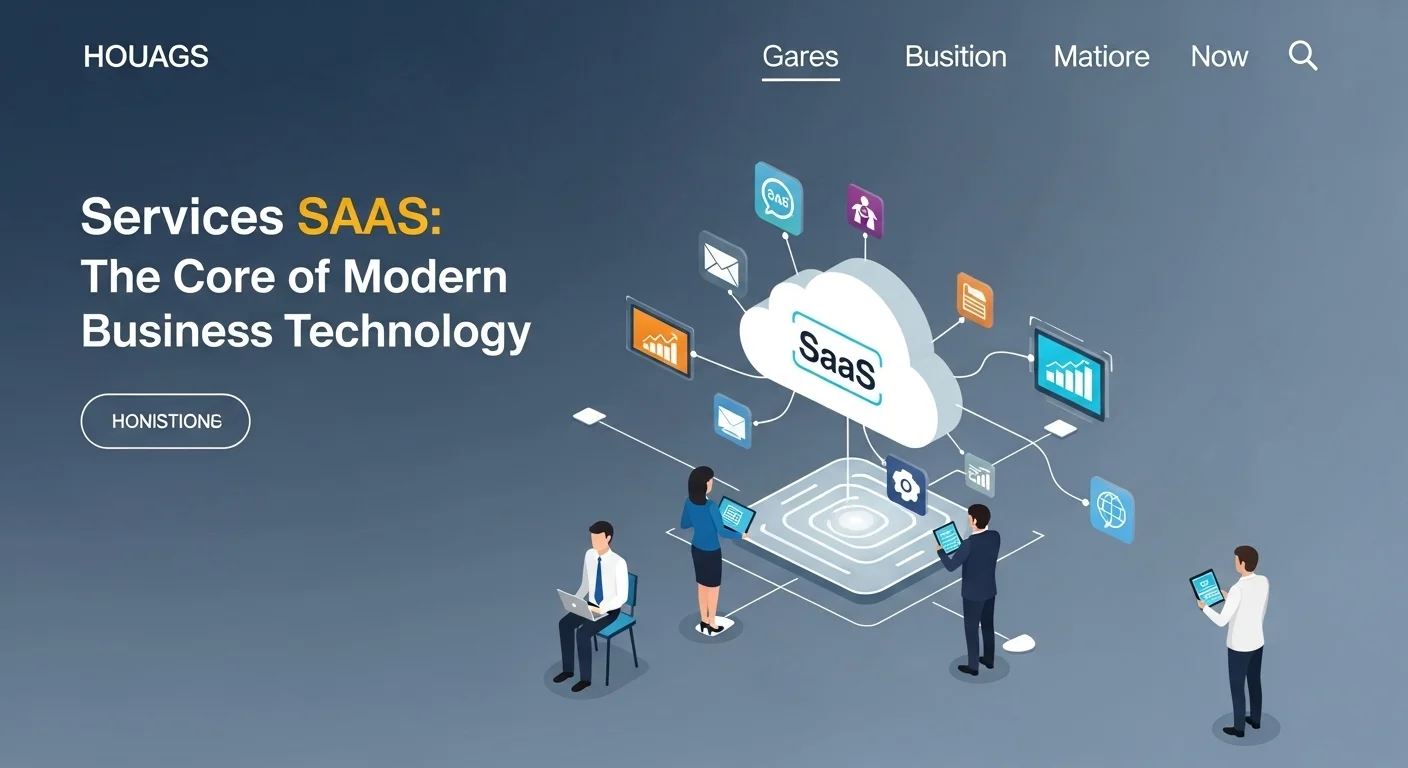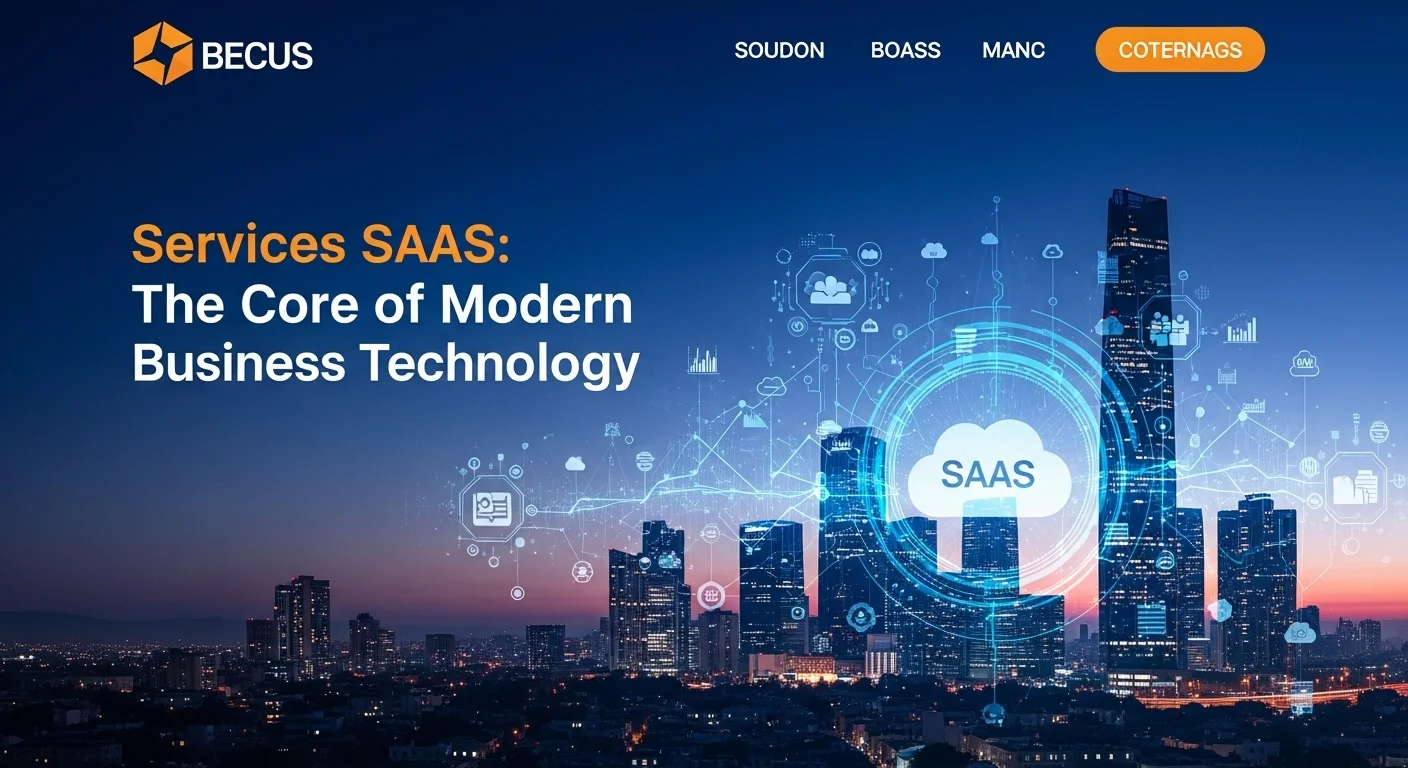A Founder's Guide to SaaS: How Software as a Service is Your Secret Weapon for Growth

Executive Summary
I still remember the days of buying software in a box. It felt like a huge commitment—a massive upfront cost and hours of installation, only to have it become outdated a year later. Then came Software as a Service, or SaaS, and it completely changed the game. It moved software to the cloud, making it accessible, affordable, and always up-to-date through a simple subscription. In this guide, I'm going to walk you through the world of SaaS from a practical, business-first perspective. We'll explore what it really is, how it gives businesses a serious competitive edge by providing powerful tools without the headache of managing hardware, and why understanding it is crucial for anyone interested in the future of technology. I'll share my experiences and break down everything from choosing the right SaaS providers to making sure all your different cloud tools work together seamlessly. My goal is to give you the knowledge to use this incredible technology to unlock new levels of productivity and agility for your business.
Table of Contents
What is Software as a Service (SaaS) and Why Does It Matter?
Table of Contents
In my years working with businesses, no single change has been more impactful than the shift to Software as a Service (SaaS). So, what is it, really? In simple terms, SaaS is a way of delivering software over the internet. Instead of buying a license and installing an application on your computer, you subscribe to it. The software is hosted on the provider's servers, and you just log in through a web browser. This frees you from the nightmare of hardware maintenance, software updates, and all the technical baggage that used to come with business technology. It’s a key piece of the 'cloud computing' puzzle, sitting alongside its more technical cousins, Infrastructure as a Service (IaaS) and Platform as a Service (PaaS). While they provide the raw building blocks, SaaS delivers the finished product—a ready-to-use application—straight to you.
The importance of SaaS today is impossible to ignore. It completely flipped the script: we went from buying a product to subscribing to a service. This move opened the floodgates, giving small and medium-sized businesses access to incredibly powerful tools that were once reserved for huge corporations with deep pockets. I've seen firsthand how a small startup can use a sophisticated CRM system, paying a predictable monthly fee instead of a crippling upfront cost. This turns a major capital expense into a manageable operating expense, which is a game-changer for budgeting. On top of that, all the boring but critical tasks—like maintenance, security patches, and updates—are handled by the SaaS vendor. This lets your IT team stop putting out fires and start focusing on projects that actually move the business forward.
The Technology Behind the Curtain
To really get why SaaS works so well, you need a peek at the technology powering it. Most SaaS platforms are built on what's called a 'multi-tenant architecture.' Think of it like an apartment building. A single, large building (the provider's infrastructure) houses many different tenants (customers). Each tenant has their own secure, private apartment (their data), but they all share the building's core resources like plumbing and electricity. This model is incredibly efficient, which is how providers can offer such competitive pricing. When the landlord decides to upgrade the building's security system, every single tenant benefits instantly. That's what happens with SaaS updates—new features appear for everyone at once, with no need for manual installations.
The other magical ingredient is accessibility. Because these tools run in a web browser, you can access them from anywhere, on any device—your office desktop, your laptop at home, or your phone while you're grabbing coffee. This is the foundation of modern flexible work. These services are powered by massive cloud platforms like Amazon Web Services (AWS), Microsoft Azure, and Google Cloud, which provide the global scale and rock-solid reliability needed to deliver a smooth experience to millions of users.
Real-World Business Applications
Today, there’s a SaaS solution for just about every part of a business. It started with tools like Salesforce, which revolutionized how companies managed customer relationships (CRM), but now the landscape is immense:
- Running the Business (ERP): Cloud-based systems from giants like Oracle and NetSuite help manage everything from finance to the supply chain.
- Managing People (HR): Platforms like Workday have streamlined everything from payroll to hiring and employee management.
- Teamwork and Communication: Tools like Slack, Microsoft 365, and Google Workspace are the digital offices for countless companies, making collaboration seamless.
- Marketing and Sales: Tools from HubSpot and Mailchimp allow businesses to automate marketing campaigns and manage their sales pipeline effectively.
- Handling the Books (Finance): SaaS products like QuickBooks Online have made professional-grade accounting accessible to even the smallest businesses.
One of the biggest draws is how these tools can talk to each other. This is where SaaS integration comes in. Using Application Programming Interfaces (APIs), businesses can connect their different SaaS apps to create automated workflows. I remember a client who connected their e-commerce store to their CRM. Suddenly, every new order automatically created a customer profile, no manual entry required. It saved them hours of work and eliminated countless errors.
The Clear Benefits for Business and Tech Leaders
For a business leader, the benefits of SaaS are crystal clear. The most obvious is cost. By getting rid of the need for expensive servers and software licenses, the total cost of ownership plummets. The predictable monthly fees also make financial planning a breeze. But beyond money, it's about speed. I've seen companies get a new SaaS tool up and running in a single afternoon, a process that used to take months with on-premise software. This agility allows businesses to adapt and innovate at a pace that was once unimaginable.
For the tech leaders I work with, like CIOs, SaaS is a way to offload the daily grind. Instead of worrying about server uptime and security patches, they can focus on strategic initiatives. And when it comes to security, reputable SaaS providers invest millions in it, often providing a level of protection that most individual companies could never afford. They have teams of experts dedicated to security, compliance, and disaster recovery. It’s a shared responsibility, of course—they secure the platform, but you're still in charge of who has access and how they use it. In short, SaaS isn't just a trend; it's the foundation of modern business strategy, offering a powerful mix of efficiency, affordability, and agility.

Your Complete Guide to Using SaaS for Business and Technology Solutions
Alright, so you understand the 'what' and 'why' of SaaS. Now let's get into the 'how.' This part of the guide is for those ready to move beyond the basics and truly master SaaS as a strategic tool. It's about more than just switching software; it's about fundamentally changing how your business operates for the better. Let's dive deep into the technical methods, business strategies, and how to intelligently compare the vast sea of SaaS providers out there.
The Technical Nitty-Gritty: Integration, Architecture, and Security
The magic of SaaS is built on a solid technical foundation. As we touched on, the multi-tenant architecture is key for efficiency. But when you're choosing a tool, you need to look under the hood a bit.
Making Your Tools Talk: SaaS Integration: In any modern business, your software can't live on isolated islands. You need your sales tool to talk to your accounting tool, which needs to talk to your project management tool. The key to this communication is the API (Application Programming Interface). Think of an API as a universal translator for software. It provides a set of rules that lets different applications share data and trigger actions in one another. When I evaluate a new SaaS tool, one of the first things I look at is the quality of its API. A powerful, well-documented API is a sign that the provider understands the needs of a modern, connected business.
For companies that need to connect many apps without a dedicated development team, platforms called iPaaS (Integration Platform as a Service) like Zapier or MuleSoft are lifesavers. They act like a central switchboard operator for all your cloud services, offering pre-built connectors that make integration a drag-and-drop process. I remember setting up a workflow for a client using an iPaaS: when a deal was marked 'won' in their CRM, it automatically generated an invoice in their accounting software, created a new project in Asana, and sent a welcome email to the new client. That single automated workflow saved them nearly 10 hours a week of manual work.
Security: A Shared Responsibility: When you move to SaaS, you're trusting a provider with your data. This can be scary, but top-tier SaaS vendors have security teams and budgets that dwarf what most companies can afford. However, it's a partnership. They secure the infrastructure (the building), but you're responsible for your data and users (what happens inside your apartment). Key things to focus on are:
- Access Control (IAM): Who gets the keys? Implementing Single Sign-On (SSO) makes life easier for users and gives you central control. Even more critical is Multi-Factor Authentication (MFA), which adds a vital layer of security against stolen passwords.
- Data Encryption: Your data should be encrypted both when it's traveling over the internet (in transit) and when it's stored on the provider's servers (at rest). Always confirm this with a potential vendor.
- Compliance: If you operate in an industry with regulations like GDPR or HIPAA, you must choose a provider that meets those standards and can provide proof.
- Due Diligence: Before you sign a contract, do your homework. Ask for their security policies and any third-party audit reports, like a SOC 2 certificate. It's a sign of a mature and trustworthy provider.
Business Strategies to Get the Most Out of SaaS
Adopting SaaS is your chance to rethink and improve your processes. Here's how to get the best return on your investment.
Automate the Boring Stuff: Look for repetitive, manual tasks in your business and ask, 'Can we automate this?' By connecting your SaaS tools, you can build powerful workflows that eliminate grunt work. This frees up your talented team to focus on creative, strategic work that actually grows the business.
Turn Data into Decisions: Your SaaS applications are goldmines of data. When you bring data from your CRM, marketing platform, and financial software together, you get a complete picture of your business's health. Using a business intelligence (BI) tool—often a SaaS product itself—you can visualize this data, spot trends, and make smarter, fact-based decisions.
Create an Unforgettable Customer Experience: SaaS gives you the tools to delight your customers. By integrating your CRM with your customer support and marketing tools, you can get a 360-degree view of every customer interaction. This allows for truly personalized communication and proactive service that makes customers feel valued.
How to Choose the Right SaaS Partner
The SaaS market is crowded. Choosing the right provider is less about buying software and more about finding a long-term partner. Here's my checklist:
- Core Functionality: Does it actually do what you need it to do, and do it well? Involve the people who will be using the tool every day in the evaluation process. Their insights are invaluable.
- Scalability and Reliability: Will this tool grow with you? Ask about their uptime guarantees (often called SLAs) and how they ensure performance remains snappy as your usage increases.
- Integration Power: How well does it play with others? Assess their API and check if they have pre-built integrations with the other key tools in your tech stack.
- True Cost: Look beyond the monthly price. Factor in potential costs for implementation, data migration, training, and support. Sometimes the 'cheaper' option ends up being more expensive.
- Vendor Health: Is this company built to last? Look at their reputation, financial stability, and customer support reviews. You're entering a partnership, so make sure your partner is reliable.
Some companies prefer an all-in-one suite from a major player like Microsoft or Salesforce, while others prefer a 'best-of-breed' approach, picking the absolute best tool for each specific job. There's no single right answer. The best choice depends entirely on your unique needs, budget, and long-term strategy. By being methodical, you can build a technology stack that truly powers your business forward.

Pro Tips and Strategies to Master Your SaaS Experience
Okay, you've chosen your tools and they're up and running. The journey doesn't end there. In my experience, the difference between companies that just 'use' SaaS and those that thrive with it lies in continuous management and optimization. This is where you go from being a consumer to a master of your tech stack. Let's talk about the practical tips and advanced strategies that will turn your SaaS investment into a powerful, secure, and efficient engine for your business.
Getting Your House in Order: Best Practices for SaaSOps
As you adopt more and more apps, you can quickly find yourself in a state of 'SaaS sprawl.' It's like that one messy drawer in the kitchen where everything gets thrown. Bringing order to this chaos is the job of SaaSOps (SaaS Operations), a fancy term for smartly managing your entire SaaS portfolio.
1. Know What You Have: The SaaS Inventory: The first rule is simple: you can't manage what you can't see. The most critical step is to create a single, centralized list of every single SaaS app being used in your company. This includes discovering 'shadow IT'—the tools your teams sign up for without telling the IT department. I've found that using a SaaS management platform (SMP) can be a lifesaver here, as it can scan your finances and login data to automatically create this inventory for you.
2. Automate Onboarding and Offboarding: Getting a new hire set up or deactivating a departing employee's accounts can be a tedious and error-prone checklist. Automating this is a huge win. When someone joins, an automated workflow can grant them access to all the right tools based on their role. More importantly, when someone leaves, automation ensures their access to everything is cut off instantly. I can't overstate how much this improves security.
3. Tame Your SaaS Budget: SaaS subscriptions can add up fast. I advise my clients to do a quarterly review of their SaaS spend. Look for redundant apps (do you really need three different project management tools?) and unused licenses. It's common to find you're paying for 50 licenses of a tool that only 20 people are actually using. Trimming this fat can result in surprisingly large savings.
Advanced Plays for Security and Compliance
Remember, with SaaS security, the provider secures the cloud, but you secure what's *in* the cloud. This requires a modern, proactive approach.
1. Adopt a 'Zero Trust' Mindset: The old idea of a secure network 'castle' with a 'moat' around it is dead in a world of cloud apps. The Zero Trust model is the new standard. It assumes no one is trusted by default, whether they're inside or outside your network. In practice, this means verifying every single access request. For your SaaS tools, it means strictly enforcing things like Single Sign-On (SSO), Multi-Factor Authentication (MFA), and giving people the absolute minimum level of access they need to do their job.
2. Use a Cloud Access Security Broker (CASB): A CASB acts like a security guard standing between your employees and your cloud apps. It enforces your security policies in real-time. For example, you can set up a policy through a CASB to block an employee from downloading a sensitive client list to their personal, unmanaged laptop, or to automatically encrypt data before it's uploaded to a specific application.
3. Never Stop Monitoring: Security isn't a one-and-done setup. You have to continuously monitor your SaaS apps for misconfigurations and suspicious behavior. There are tools for this, sometimes called SSPM (SaaS Security Posture Management), that automatically check your settings against security best practices. Regular audits and reviews of who has access to what are also non-negotiable for keeping your data safe.
Unlocking True Value: Integration and User Adoption
A powerful tool is worthless if your team doesn't use it or doesn't use it well. The final piece of the puzzle is human.
1. Build an Integration Roadmap: Don't just connect apps randomly. Think strategically. Identify your most critical business processes and prioritize the integrations that will have the biggest impact. For example, connecting your CRM to your support desk so that sales reps can see active support tickets before calling a client. This kind of strategic thinking ensures your efforts are focused on what matters most.
2. Champion User Training and Adoption: I've seen companies spend a fortune on a new tool only to have it fail because of poor adoption. You have to invest in training that goes beyond the basics and shows your team how the tool makes *their* specific job easier. Create internal guides and find enthusiastic 'power users' within your teams who can act as champions and help their colleagues.
3. Create a Feedback Loop: Your users are your best source of information. Regularly ask them for feedback. What are their biggest frustrations with the current tools? What features would make their lives easier? This feedback is gold. It helps you refine your processes and tells you what to ask for from your SaaS vendors. This keeps your tech stack evolving right alongside your business.
For those interested in the business of building SaaS companies, I highly recommend the blog from the venture capital firm Andreessen Horowitz (a16z). They offer incredible insights into the metrics and strategies behind the world's most successful SaaS businesses.
Ultimately, treating SaaS as a strategic asset is about discipline, security, and a deep focus on your people. By embracing these practices, you can transform your collection of cloud services into a truly cohesive and powerful advantage in the market.
Expert Reviews & Testimonials
Sarah Johnson, Business Owner ⭐⭐⭐
This was a great overview. As a small business owner, I would have loved a few more real-world case studies of how companies like mine have used SaaS to grow. But the foundation is solid.
Mike Chen, IT Consultant ⭐⭐⭐⭐
A really solid breakdown of SaaS. As an IT consultant, I appreciated the detail on integration and security. Some of the technical points could be simplified a bit for beginners, but it's a valuable resource.
Emma Davis, Tech Expert ⭐⭐⭐⭐⭐
Fantastic article! It's one of the most comprehensive and clearly explained guides on SaaS I've come across. It connected a lot of dots for me. A must-read for anyone in tech.



